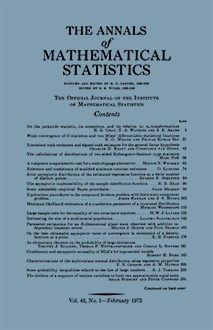Abstract
Let $X(t) \sim N(\mu t, \sigma^2t)$ be a Wiener process for $t \geqq 0$. Suppose $\sigma^2$ is known and that $H_1, \cdots, H_K$ are $K$ hypotheses concerning the unknown drift parameter $\mu$. A general sequential testing procedure presents itself in the following form: Continue to observe $X(t)$ until, for the first time $s$, the point $(s, X(s)) \varepsilon B$, a subset of the right half plane. $B$ will be called the boundary. Let $B$ be partitioned into $K$ disjoints subsets $B_i (i = 1, \cdots, K)$ called boundary sets. Then, if $(s, X(s)) \varepsilon B_i$, one accepts $H_i$. In this paper, we will assume that each boundary set $B_i$ is composed of a finite number of straight lines or line segments called boundary lines. Any test using such a procedure (for some $K$) will be called a boundary test. We shall derive recursive methods for computing the exact OC functions, the average sample time (AST), and, in fact, all the moments of the sampling time $\tau$. Even though the study of tests for Wiener processes seems to be of intrinsic interest, their study usually has been motivated by other considerations. T. W. Anderson [1] has developed an approximate test for the unknown mean of the normal distribution by relating his testing procedure with a corresponding boundary test. In a similar manner, one may derive Wald's sequential probability ratio test, the Neyman-Pearson fixed sample size test, and multistage tests, for the mean of the normal distribution. The restriction to a finite number of (straight) boundary lines may seem unpleasant but, of course, curvilinear boundaries can be approximated with polygonal lines. One consequence of the restriction is that there will exist at most a finite number of times at which an end-point of a boundary line, an intersection of two boundary lines, or a vertical boundary line occurs. These times, coupled with times $t = 0$ and $t = \infty$, will be called critical times. The recursive methods developed below will allow us to reduce the computations of the OC functions and the moments of $\tau$ to the computation of certain "fundamental probabilities" involving events which occur between critical times. We shall denote the critical times as $0 = t_0 < t_1 < \cdots < t_m < t_{m+1} = \infty.$ The points $(s, x)$, with $s \geqq 0$, which are not in the boundary $B$ will be denoted by $B_0$. A point in $B_0$ which can be reached by a continuous sample path before time $\tau$ will be called an accessible point. Otherwise, the point is an inaccessible point. An important subclass of the class of boundary tests is the class of boundary tests which are closed for all values of $\mu$. This class has three characterizations (See [3].): \begin{align*}\tag{i}P_\mu\lbrack\tau < \infty\rbrack = 1 \text{for all} \mu. \\ \tag{ii}E_\mu(\tau^r) < \infty \text{for all} \mu, \text{for} r = 1, 2, \cdots.\end{align*} (iii) Every accessible point of the form $(t_m, x)$ is contained between two parallel, non-vertical boundary lines extending to infinity. Sections two and three will present the recursive procedures for computing the OC functions and the moments of the stopping time $\tau$, respectively. Section four discusses the computation of the "fundamental probabilities." The reader will quickly perceive that the recursive methods presented below need not be limited to straight line boundaries. The limitation arises from the rather restricted class of computable fundamental probabilities (at the present time).
Citation
Gordon Simons. "A Class of Sequential Procedures for Choosing One of $K$ Hypotheses Concerning the Unknown Drift Parameter of the Weiner Process." Ann. Math. Statist. 38 (5) 1376 - 1383, October, 1967. https://doi.org/10.1214/aoms/1177698693
Information





